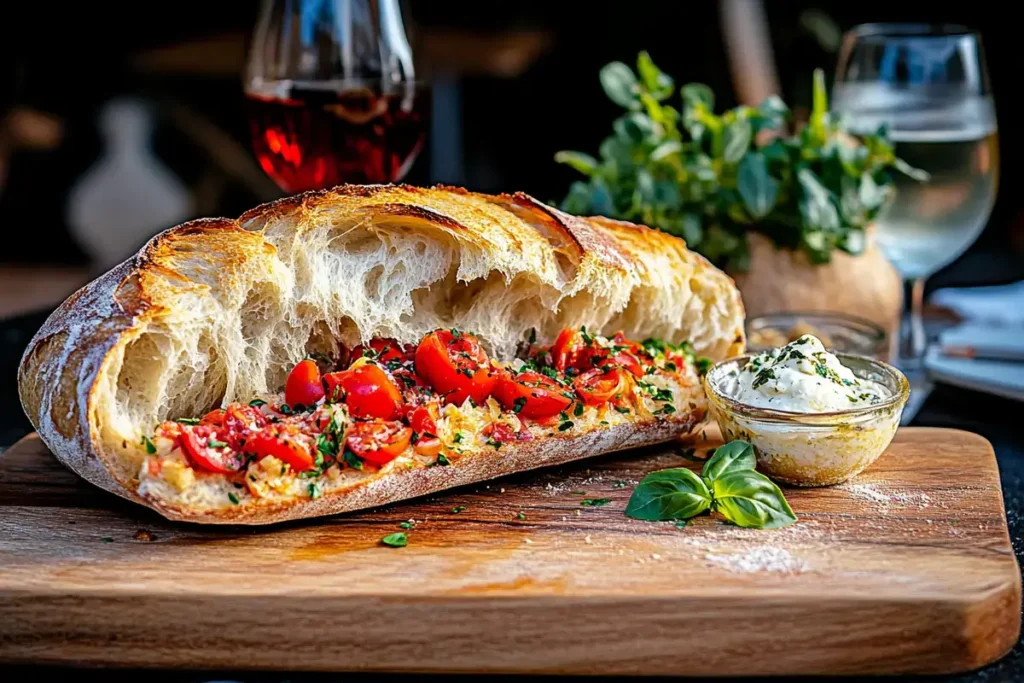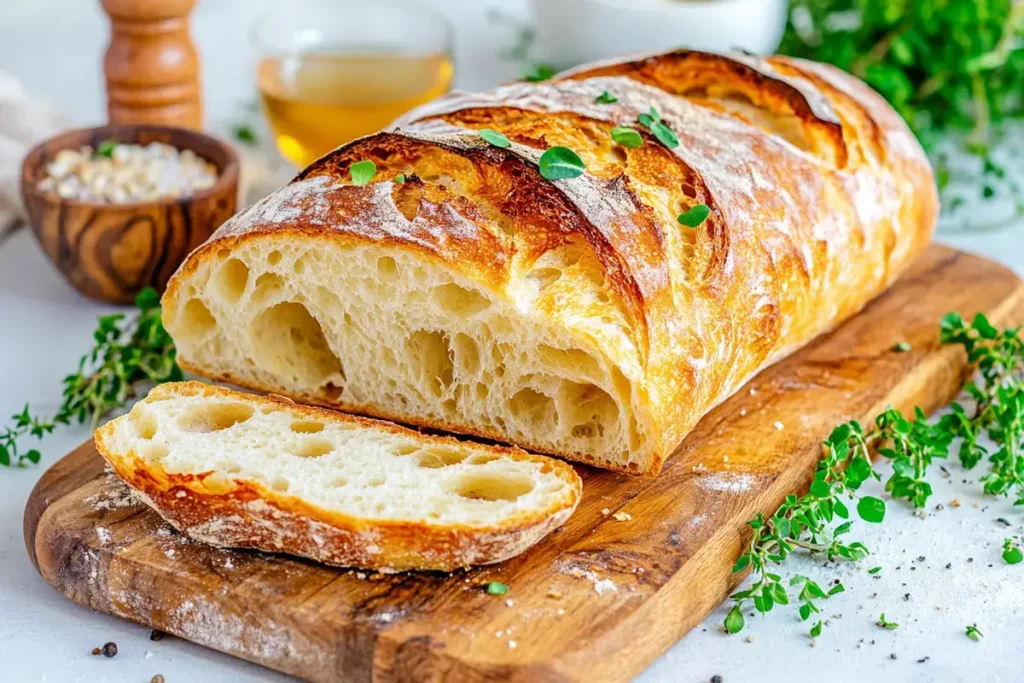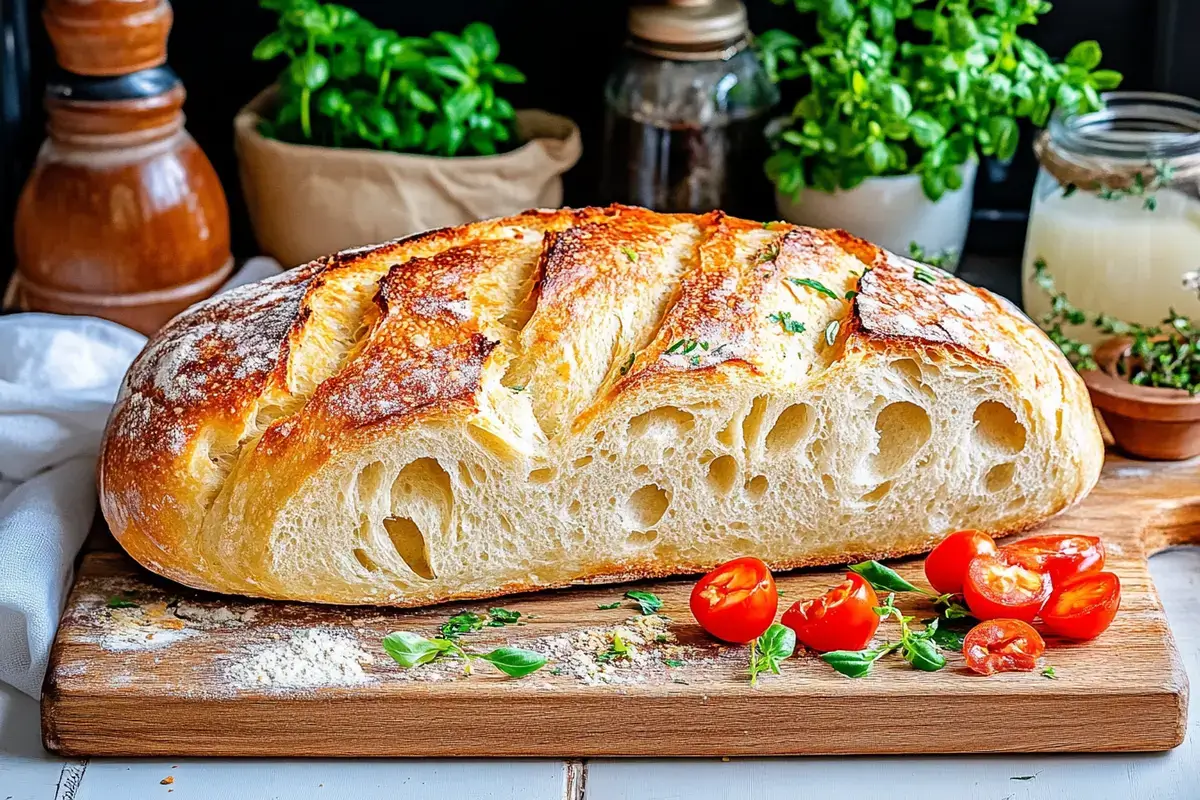Hey everyone, Jessika here from BoldyRecipes.com! As someone who’s developed recipes for gluten-free bakeries from Portland to Miami, I’m constantly asked about which breads are safe for gluten-sensitive diners. Today, let’s tackle a common misconception about ciabatta and explore your best gluten-free alternatives.
The Clear Answer: No, Traditional Ciabatta Contains Gluten
Let me be crystal clear upfront: traditional ciabatta is NOT gluten-free. This Italian bread is made primarily with wheat flour, which contains significant amounts of gluten the protein that gives ciabatta its characteristic chewy texture and open crumb structure.
In my professional kitchen here in Austin, I’ve worked with countless clients managing celiac disease or gluten sensitivity, and ciabatta is always on the “absolutely avoid” list. The wheat flour used in authentic ciabatta contains approximately 12-14% gluten protein, making it one of the higher-gluten breads available in American bakeries.

Understanding Gluten in Ciabatta
Ciabatta’s unique texture actually depends on gluten development. During my apprenticeship at a renowned Italian bakery in Chicago, I learned that ciabatta’s signature holes and chewy crust result from extensive gluten formation during a long, slow fermentation process. The high hydration (water content) and vigorous mixing create strong gluten strands that trap gas bubbles, forming those distinctive air pockets.
A standard 2-ounce serving of ciabatta contains roughly 5-6 grams of gluten protein. For context, someone with celiac disease can’t tolerate even 20 parts per million of gluten that’s about 1/64th of a teaspoon of flour. This makes regular ciabatta completely unsuitable for anyone avoiding gluten for medical reasons.
Who Needs to Avoid Ciabatta?
Through my work with nutritionists across Texas medical centers, I’ve identified three primary groups who must avoid traditional ciabatta:
Celiac Disease Patients: Approximately 1% of Americans have celiac disease, an autoimmune condition where gluten damages the small intestine. Even trace amounts trigger serious health consequences.
Non-Celiac Gluten Sensitivity: About 6% of the U.S. population experiences digestive discomfort, fatigue, or headaches from gluten without having celiac disease.
Wheat Allergy Sufferers: Though less common, wheat allergies affect about 0.4% of American adults and require complete wheat avoidance.
Gluten-Free Ciabatta Alternatives
The good news? The gluten-free market has evolved tremendously since I started blogging in 2015. Several options now replicate ciabatta’s texture reasonably well:
Commercial Gluten-Free Ciabatta: Brands like Schär and Against the Grain offer gluten-free ciabatta rolls available at Whole Foods and Sprouts nationwide. These use rice flour, tapioca starch, and xanthan gum to mimic traditional texture. Expect to pay $6-8 for a 4-pack about double the regular price.
Homemade Versions: In my Seattle test kitchen, I’ve developed a gluten-free ciabatta using a blend of brown rice flour, potato starch, and psyllium husk. The key is achieving the right hydration level around 90% for gluten-free versus 75% for traditional.
Alternative Bread Options: Consider naturally gluten-free breads like Ethiopian injera (made from teff) or Brazilian pão de queijo (tapioca-based). These offer unique flavors while keeping meals safe for gluten-sensitive guests.

Shopping and Dining Tips
When shopping for gluten-free ciabatta in stores from Los Angeles to Boston, always verify certification labels. Look for “Certified Gluten-Free” symbols, which guarantee less than 20ppm gluten content. Be cautious of “wheat-free” labels these don’t necessarily mean gluten-free, as barley and rye also contain gluten.
At restaurants, never assume ciabatta is gluten-free, even at Italian establishments claiming extensive gluten-free menus. Cross-contamination in shared ovens and prep areas poses serious risks. I’ve consulted with restaurant chains across the Southwest, and proper gluten-free protocols require dedicated equipment and preparation spaces.
Making Peace with Gluten-Free Living
After helping hundreds of home cooks adapt to gluten-free diets, I understand the initial disappointment of giving up beloved breads like ciabatta. However, the expanding variety of quality alternatives makes this transition easier than ever. Focus on naturally gluten-free whole foods, experiment with alternative flours, and remember that your health improvement makes these adjustments worthwhile.

FAQs
Q: Can sourdough ciabatta be gluten-free?
A: No, fermentation doesn’t eliminate gluten; it only partially breaks it down. True gluten-free requires gluten-free flours.
Q: What’s the best gluten-free flour for ciabatta texture?
A: A blend of brown rice flour, tapioca starch, and psyllium husk best replicates ciabatta’s chewiness.
Q: Is European ciabatta different gluten-wise?
A: No, Italian and American ciabatta both contain gluten from wheat flour, regardless of origin.
Q: How much does gluten-free ciabatta cost?
A: Typically $6-8 for 4 rolls, about 2-3 times more than regular ciabatta due to specialty ingredients.

